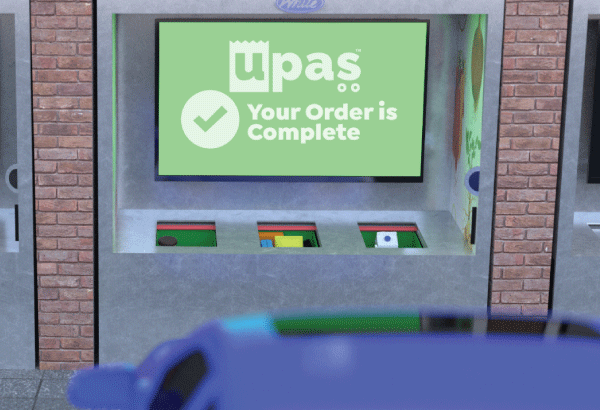Operator-run automated storage solutions are increasingly being used for curbside grocery pickup.
But the next wave in grocery eCommerce will be centered around remote unattended order pick-up. Many of these new systems rely on integrated smart “buffers,” i.e., remote places where completed orders can be staged for customer pick-up.
These buffers can be placed wherever is most advantageous to the grocer. For example, one could be located inside a shopping mall. That way, customers could pick up their groceries at the same time they are shopping for standard retail items.
Some of these automated storage systems may even include point-of-sale items. The BuyBox solution offers retailers both options: storage buffering of online orders until they can be picked up by the customer and point-of-sale items, as well.

UPAS™ (Unattended Pickup at Store) System offers unattended grocery pick-up
White’s UPAS™ (Unattended Pickup at Store) System, patent pending, is designed to help grocers adapt to the rapidly changing market and increase in online orders. UPAS is a fully customizable system offering either attended or unattended temperature-controlled customer pickup windows that are weather resilient and can be installed inside or outside of grocery stores. It provides 24×7 accessibility with high throughput and delivery speeds on customer orders so grocers can maximize workforce efficiency.
With UPAS, a customer can place their order online, drive up, and take their groceries out of temperature-controlled storage. The integrity of the products they order is maintained exactly as they were in the store, and after they obtain their order, the customer can just drive away. The entire process can be contact-free. The customer doesn’t have to walk in the store. They don’t even have to touch the customer interaction window. That means a customer can drive up, park, retrieve their order, and have it delivered into the truck of their car in less than five minutes.
UPAS works in combination with a grocer’s existing app technology for online shopping. After placing their order, the customer uses the app to let UPAS know that they’re close to the pickup site. UPAS queues up the order, removing it out of the storage buffer and delivering it to the awaiting pickup bays. Then, the customer pulls up, confirms their identity with the UPAS system, and UPAS releases the order, allowing for seamless and expedient pickup. (For grocers that do not have an app, customer could scan a QR code that would signify the order to be dispensed from UPAS and delivered to the pickup windows.)
UPAS integrates with grocer infrastructure to provide 24×7 accessibility with high throughput
If UPAS is part of the grocery store, it is fed by the employees who are picking the orders. It integrates with the grocer’s current operating structure and allows for the personal shoppers to directly load the totes. If UPAS is part of a remote solution, it can be filled with orders from a micro-fulfillment center. These orders can be placed in a delivery vehicle and then loaded remotely into UPAS for unattended remote pickup. UPAS also has capability to handle 3rd party delivery drivers as well as drone technology integration.
Combining micro-fulfillment technology with UPAS for customer order fulfillment optimizes grocery eCommerce. Today’s customers want to pick up their groceries whenever it’s most convenient for them, and they want the process to be as fast and efficient as possible. Micro-fulfillment centers allow grocers to better control the flow of their personal shoppers, maintain tighter control over inventory, and fill customer orders quicker and more accurately. UPAS provides 24×7 accessibility with high throughput and delivery speeds on customer orders. Combining these two solutions enhances the customer experience while preserving margins.
Grocers using The White Grocery Carousel report improved efficiencies and quicker customer pickup times
Retailers using The White Grocery Carousel are reporting improved efficiencies and quicker customer pickup times vs traditional tote/pallet or shelf order storage. After customers order their groceries online, these grocers can have the orders ready for pickup within two to four hours. Pickup departments can now be equipped to produce orders every five minutes, for multiple customers per hour. That kind of speed and efficiency can be a real game changer for grocers looking to differentiate themselves in this competitive marketplace without having to spend millions on an entire new system.
Grocery shoppers choose where to shop based on convenience and speed
As grocers move forward with click and collect business models, they need to choose technology partners with the expertise and experience to create innovate, customized solutions. Some stores can be restricted by parking spaces. Others may be restricted by the workers and size of pickup departments. In these instances, storage buffering may be optimal. Think about ten customers coming to a pickup department every fifteen minutes, each one with five totes in their order. That’s 50 totes that need to be delivered out of that department within 15 minutes. Any delays can create a significant backlog, and that can create even more demand on the workforce.
The major drivers of customer satisfaction are letting customers arrive for pickup whenever it’s most convenient for them and then providing a pickup system that’s quick and efficient. The grocers that are able to provide that level of customer service are going to see the return on margin. They will see greatest amount of value, while reducing costs.
